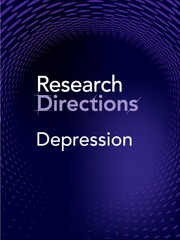Context
The recognised heterogeneity of clinical cohorts of people with depression and other mood disorders has been held to be one of the central reasons why so many studies of causation, neurobiological or psychological correlates, or the effectiveness of treatments have failed to yield significant findings or be easily replicated by independent groups.
It is a major problem across all of psychiatry that the heterogeneity within diagnostic groups often exceeds that between diagnostic categories. This is especially the case for depression and other mood disorders where some sub-groups share more in common with other diagnostic categories, and, most importantly, patterns of differential response to common pharmacological or psychological treatments (e.g. those with psychotic depression are more similar to those with other psychotic disorders than those with non-psychotic mood disorders; those with atypical depression are more similar to those with bipolar depression than those with unipolar depression; those with anxious major depression are more similar to those with post-traumatic stress disorder than those with major depression alone).
Despite the clinical utility and historical persistence of demographically-based (e.g. early-onset vs late-onset) or phenotypically-based distinctions (bipolar vs unipolar, typical vs atypical, melancholic vs non-melancholic, psychotic vs non-psychotic, episodic vs chronic and persistent and treatment-responsive vs treatment-resistant), and the inclusion of such sub-typing categories within diagnostic systems, this has not led to great progress in the field. Clinicians have a strong preference, and urgent need, to link more precisely observed behavioural phenomena with underlying pathophysiology to underpin optimal treatment selection.
Consequently, a range of new illness-onset, course and other observed systems have been proposed, including clinical staging or more tightly defined illness trajectories (anxious child to anxious-depressed teenager, circadian depression) as better potential markers (Hickie et al., Reference Hickie, Scott, Cross, Iorfino, Davenport, Guastella, Naismith, Carpenter, Rohleder, Crouse, Hermens, Koethe, Markus Leweke, Tickell, Sawrikar and Scott2019; Shah et al., Reference Shah, Scott, McGorry, Cross, Keshavan, Nelson, Wood, Marwaha, Yung, Scott, Öngür, Conus, Henry and Hickie2020; McGorry and Hickie, Reference McGorry and Hickie2019). However, these approaches still rely heavily on observed phenotypic, retrospective trajectories or longitudinal illness-course features. While they may propose underlying mechanisms (e.g Hypothalamic-Pituitary-Adrenal axis dysfunction; circadian pathophysiology) as the likely pathophysiology, they do not directly document such factors.
By contrast, others propose that we need to make much greater use of independent laboratory, brain, genetic or other observable markers – and determine their relationships with clinical phenotypes, illness stage, treatment response or illness course (McGorry et al., Reference McGorry, Keshavan, Goldstone, Amminger, Allott, Berk, Lavoie, Pantelis, Yung, Wood and Hickie2014). These include a wide range of existing and novel immune, metabolic, brain imaging and electrophysiological markers. Additionally, there is a wide range of cognitive and neuropsychological features that can be reliably recorded. Whether new genetic and other metabolic and proteomic markers will enhance the field is unknown. The extent to which these markers reflect underlying pathophysiological markers, genuine sub-types or predictors of illness course or treatment response as distinct from being markers of age, chronicity or prior treatment exposures remains controversial.
Another alternative approach is to focus on patterns of response versus non-response to established (typically SSRIs, SNRIs or Lithium) or novel (e.g. ketamine, melatonin-based agents) pharmacological, psychological or physical (e.g., ECT, rTMS) treatments. This approach has the capacity to work back to elucidate more fundamental biochemical, physiological or genetic factors that underpin the drivers of specific sub-groups of common mood disorders. However, this approach is limited by the range of current treatments available and our understanding of their actual mechanisms of action.
So, there is an urgent need to set an agenda for the ways in which stratification of depressive and other mood disorders may usefully proceed. An emphasis on development of new methods, agreed ways of assessing the validity of proposed markers (after controlling for relevant age, treatment and chronicity confounds) and linking to relevant clinical, population-based, developmental or other informative cohorts, are high priorities.
How to contribute to this Question
If you believe you can contribute to answering this Question with your research outputs find out how to submit them in the Instructions for authors (https://www.cambridge.org/core/journals/research-directions-depression/information/author-instructions/preparing-yourvetech-materials). This journal publishes Results, Analyses, Impact papers and additional content such as preprints and “grey literature”. Questions will be closed when the editors agree that enough has been published to answer the Question so before submitting, check if this is still an active Question. If it is closed, another relevant Question may be currently open, so review all the open Questions in your field. For any further queries check the information pages (https://www.cambridge.org/core/journals/research-directions-depression/information) or contact this email (depression@cambridge.org).
Competing interests
Ian Hickie is the Co-Director of Health and Policy at the Brain and Mind Centre (BMC) University of Sydney. The BMC operates early-intervention youth services at Camperdown under contract to headspace. He is the Chief Scientific Advisor to, and a 3.2% equity shareholder in, InnoWell Pty Ltd, which aims to transform mental health services through the use of innovative tecnologies.







